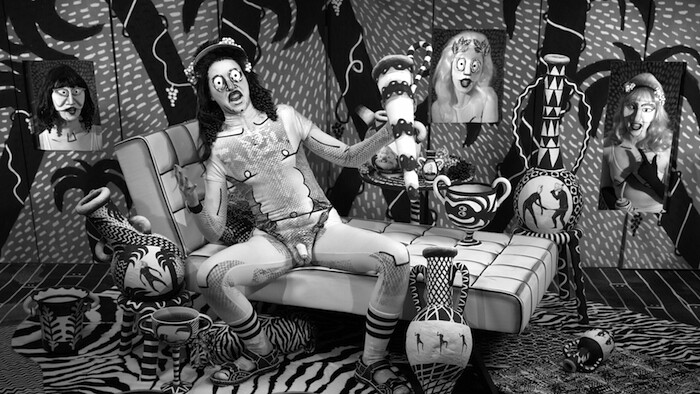— Conservative approaches, armpit hair, self-interest
1. Be conservative, buy art
Various contributors notice a conservative turn in the various spring fairs and gallery weekends. Considering how recent changes in German tax law might affect the Berlin gallery scene, e-flux conversations Editor Karen Archey reviews Gallery Weekend Berlin, commenting on the exceptions to a general “conservatism” from “younger galleries,” while for Tim Gentles Frieze New York “feels like a good weekend to go to something you loathe, run into people you sort of know, and make small talk about the inanity of it all.” From Independent Brussels, Arielle Bier remarks that “what started out as an art fair made for artist audiences has turned into a fair organized by dealers for dealers, who were clearly more excited than anyone else about each other’s booths.” Traveling across these various events, Stefan Kobel observes how fairs aim “to revitalize the discourse around contemporary art and bring it back into the gallery space,” while regretting that “participating galleries chose to play it safe (…) the result (being) an overwhelming majority of unadventurous presentations that guarantee sales.”
2. The future is still Barbarian
Considering the critical relation between large exhibitions and their host country’s history and present, Jon Bywater reviews “The future is already here—it’s just not evenly distributed,” the 20th Sydney Biennale, noticing how “the unprecedented displacement of people today is [curator] Stephanie Rosenthal’s starting point,” while from Limerick Aoife Rosenmeyer reviews “Still (the) Barbarians,” the 2016 edition of EVA International, observing that curator Koyo Kouoh “uses it as a platform to consider how the legacies of colonialism affect the world today,” while evaluating “the complexity of shifting, interdependent histories that Kouoh’s enterprise demands and reveals.”
3. There was an actual bar too, of course, and much underground activity
Looking back on Kunsthalle Athena’s five years of activity, Dimitris Politakis writes a SPACES feature focusing on an institutional experiment that “left a big mark in the world of contemporary artistic expression in Athens, recasting the curatorial process and creating a blueprint to be followed by the young crowd.” And Barbara Sirieix goes “Just below the ground” to explore the taxonomy of the underground gallery, digging out its imaginary and cultural references as well as some of the most remarkable architectonic experiments for underground spaces for art.
4. Armpit hair, pink allergy, ars combinatoria
Ana Teixeira Pinto reviews Mary Reid Kelley’s “The Minotaur Trilogy.” “Reminiscent of German Expressionism, the monochromatic film sets are painted on canvas, in a syncretic blend of camp and queer”; Pinto notes that “the return of the Minotaur is (…) the return of that which hardly ever finds cultural expression: female sexual desire, so often displaced and misrepresented as the desire to be looked at.” At the same time, Patrick Langley observes how Shelagh Wakely’s work “was overlooked during her lifetime and her best installations, which explored ideas of permanence, fragility, material transition, and transformation in relation to sculptural form, deserve greater recognition.” In light of how Rosa Barba “is constantly reworking her pieces,” Helena Tatay considers the translations at stake at Barba’s show in Madrid, some of whose works “are the result of expanding her strategies and experience of site-specificity to indoor exhibition spaces.”
5. Self-interest, the average Joe, material dependency
Looking to Baudelaire’s definition of nature as the voice of self-interest, Thyrza Goodeve observes how Mark Dion’s New York exhibition echoes how “we live in an era when this self-interest has cast the very planet we live on into a melancholy condition” while revealing “Dion’s cogent, nuanced, and up-to-the-minute dissection of this self-interest we call nature.” Writing from Shanghai, Heidi Ballet reviews Liu Ding’s “Li Jianguo Born in 1952,” observing how “Liu Ding’s curatorial research with his collaborator and wife Carol Yinghua Lu took a new turn (…) to take a self-reflexive approach and look at the roots of contemporary Chinese art by studying the legacy of Socialist Realism.” From Tokyo, Stuart Munro writes about the dialogue between Robert Morris and Kishio Suga’s works, and how “both set out to express the world as connected and vital. It is as if they were meant to be seen this way, filling the room and respective landscape with a ‘dependency’ on material.”
6. A mixture of elation, of adulation, and of consideration
Qinyi Lim’s Hong Kong Roundup is written in a climate haunted by the “mysterious international disappearances of five staff members from Hong Kong publishing house and bookseller Causeway Bay,” and she reflects on how the “heady mix of apprehension and celebration became apparent in the different energies and temporalities channeled into events and exhibitions outside of [Art Basel Hong Kong]—a mixture of elation, of adulation, and of consideration.” From Kassel, Antje Stahl reviews the “Images” exhibition at the Fridericianum, curated by Director Susanne Pfeffer, considering how “‘Images’ is not just a retrospective of a famous few” but “rather a byproduct of Pfeffer’s impressive research—a representation of what data-based artwork, maneuvering between copyright and authorship, image and imagination, looked like in the past: like a hopeful future”; while Andrew Weiner reviews “David Hammons: Five Decades” in New York, observing that “by assembling many of Hammons’s sculptures, prints, and paintings, the exhibition offers a valuable opportunity to complicate received views” on an artist who “has consistently rearticulated the relation between race, sense, and materiality,” and that the “show succeeds primarily in reminding us that much more remains to be thought and said about Hammons.”
To be continued



